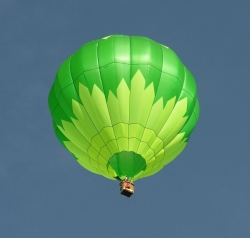Heat makes things move up. Like an elevator. Like a rocket. Like a bird soaring into the sky. And yet there is nothing pulling it up, like the line that pulls an elevator up. There does not have to be an explosion like a rocket to shoot it up. It does not have wings to carry it into the air. So what is this force that moves heat upward? How does heat fly?
There are two boxes that need to be carried upstairs. One of the boxes is filled with clothes that have not been folded, just tossed in there. The other is filled with books that have been set in neat piles so a lot of them fit inside. Which do you think will be heavier? The box of books, of course.
Density is how much stuff is packed inside of a space. The box with clothes has a low density because there is a lot of space between the unfolded clothes. The box of books has a high density because there is a lot of stuff packed in there. On Earth, things with higher density tend to weigh more than things with lower density. You are carrying a lot more stuff! Things with lower density act differently in the world. A balloon filled from a tank will act differently than a balloon you fill with your breath. That's because the gas in the tank that makes the balloon float is less dense than your breath. There is a lot of space between the small parts that make up the gas. And no, we cannot tie balloons to the boxes to lift them up the stairs.

I think we should put these into smaller boxes.
After you carry up the clothes box, I think you deserve some Jell-O. Here's a spoon. What does density, or the closeness of building blocks have to do with heat, you ask? Things that are heated up have less density. Warm building blocks get excited, they start to shake, and then they move apart. Water can move around more easily than ice because it is warmer. Its building blocks are not very close together. Each part of the water can move around all the other parts. That's why you can swim through it.
Fluid is anything where the tiny bits that make it up can move around into different shapes. Air, water, and even the gas inside the lights in your classroom are all different kinds of fluids. Let me ask you this. Is your Jell-O more like water or more like ice? A question for the ages.

You'd have to be pretty small to swim through a bowl full of Jell-o.
How do these building blocks go from moving through water to being able to fly? Let's put a piece of ice into a pot on the stove. When we turn on the fire, it starts to warm up. The ice is locked together, but the heat makes the building blocks in the ice begin to break up and move apart. This makes them less dense and able to move like a fluid. If we let the fire get even hotter, the building blocks will really start to move apart! They become so light that gravity cannot hold them down anymore. They need more space to move around so they move up into the air, like little fluttering butterflies.
Convection is when things with a lot of heat energy move up, because they are less dense than the stuff around them. Are you hoping to get the box of books to fly to the top of the staircase? Because that will not happen unless we set it on fire. And this we cannot do. There are some very good books in here.
Finally! You got the box of books to the top of the staircase. It's hot. You're sweaty. Let's go for a walk to cool down. Feel that breeze? Nice, right? Would you believe that wind is caused by heat rising? Let me explain. When you enter a crowded train station, you need to push people out of the way, right? Well, don't push. But people need to move to make space for you. When you take a step, you leave room for someone else to move in. A
convection current is when hot air or liquid moves up and cold air or liquid moves down to replace it, over and over again. It is easy to think of this happening in a circle. When heat moves upward, the cold air up there has to move. It has to get out of the way! This is a good thing. Something needs to go fill the empty space that the hot air just left. Otherwise we would not be able to breathe. So when hot air moves up, cool air rushes in to fill it. And we get wind. Cool? Cool.

Up up and away!
Greg Goebel, Public domain, via Wikimedia Commons
Are you jealous that heat can make things rise into the air? It would be a lot easier than carrying a heavy box of books. All you would have to do is get it a little hot, spread out a little and lift up. The only bad part is that when molecules move apart, they're probably not going to come back together in the same shape they were in before. So let's not set the books on fire. Best to just carry them up.
References:Kids Geo. "Convection" Kids Geo, 2010. <
http://www.kidsgeo.com/geography-for-kids/0064-convection.php>
"Physics for Kids: Heat Energy."
Ducksters. Technological Solutions, Inc. (TSI), 2014. <http://www.ducksters.com/science/heat.php>